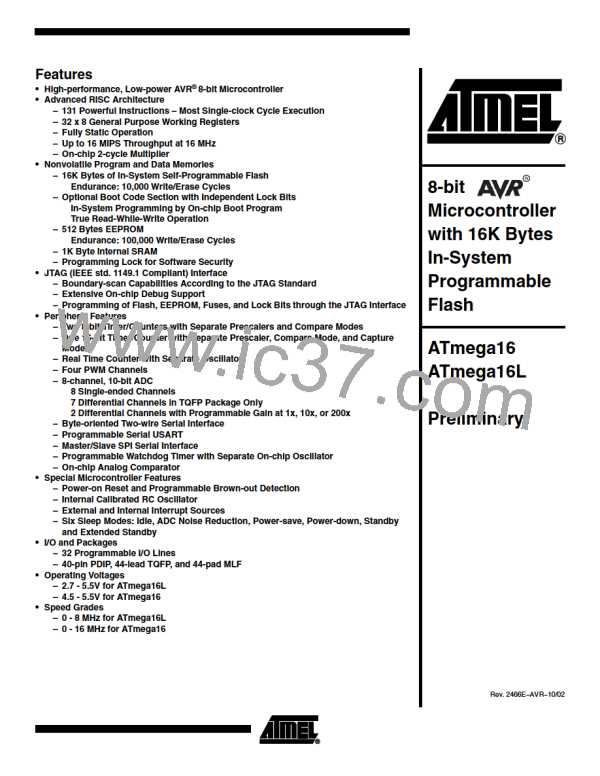When this Oscillator is selected, start-up times are determined by the SUT fuses as
shown in Table 10. XTAL1 and XTAL2 should be left unconnected (NC).
Table 10. Start-up Times for the Internal Calibrated RC Oscillator Clock Selection
Start-up Time from
Power-down and
Power-save
Additional Delay
from Reset
SUT1..0
00
(VCC = 5.0V)
Recommended Usage
BOD enabled
6 CK
6 CK
6 CK
–
01
4.1 ms
65 ms
Reserved
Fast rising power
Slowly rising power
10(1)
11
Note:
1. The device is shipped with this option selected.
Oscillator Calibration Register
– OSCCAL
Bit
7
6
5
4
3
2
1
0
CAL7
R/W
CAL6
R/W
CAL5
R/W
CAL4
R/W
CAL3
R/W
CAL2
R/W
CAL1
R/W
CAL0
R/W
OSCCAL
Read/Write
Initial Value
Device Specific Calibration Value
• Bits 7..0 – CAL7..0: Oscillator Calibration Value
Writing the calibration byte to this address will trim the Internal Oscillator to remove pro-
cess variations from the Oscillator frequency. This is done automatically during Chip
Reset. When OSCCAL is zero, the lowest available frequency is chosen. Writing non-
zero values to this register will increase the frequency of the Internal Oscillator. Writing
$FF to the register gives the highest available frequency. The calibrated Oscillator is
used to time EEPROM and Flash access. If EEPROM or Flash is written, do not cali-
brate to more than 10% above the nominal frequency. Otherwise, the EEPROM or Flash
write may fail. Note that the Oscillator is intended for calibration to 1.0, 2.0, 4.0, or
8.0 MHz. Tuning to other values is not guaranteed, as indicated in Table 11.
Table 11. Internal RC Oscillator Frequency Range.
Min Frequency in Percentage of
Nominal Frequency (%)
Max Frequency in Percentage of
Nominal Frequency (%)
OSCCAL Value
$00
$7F
$FF
50
75
100
150
200
100
28
ATmega16(L)
2466E–AVR–10/02

 ATMEL [ ATMEL ]
ATMEL [ ATMEL ]